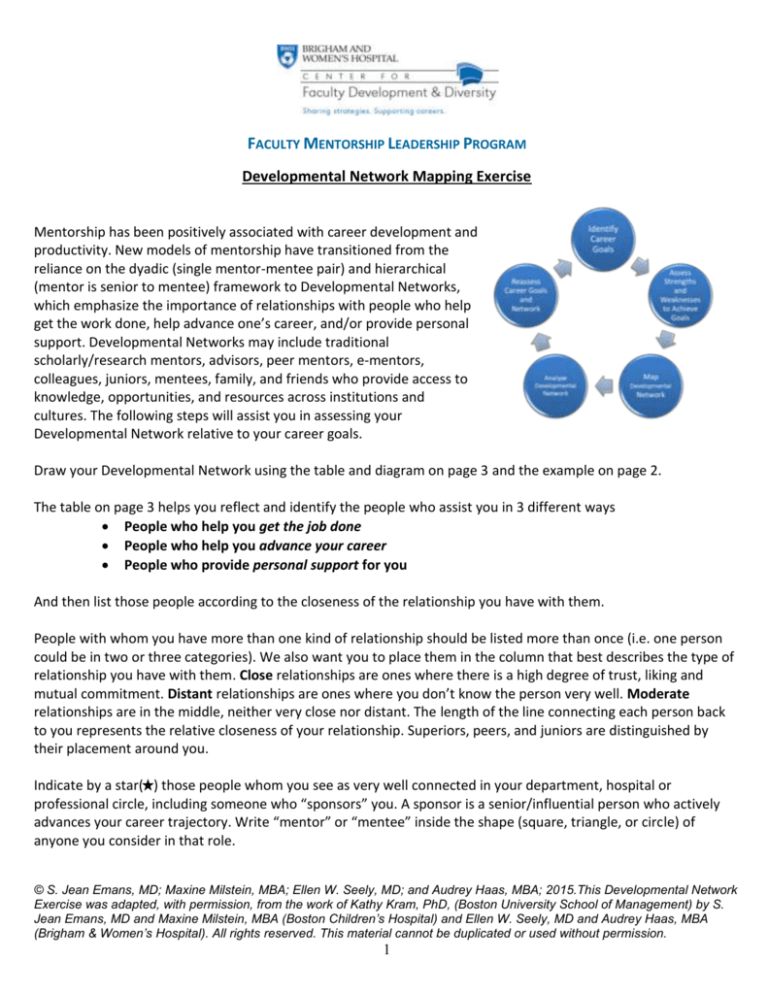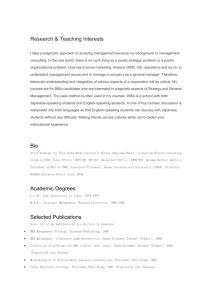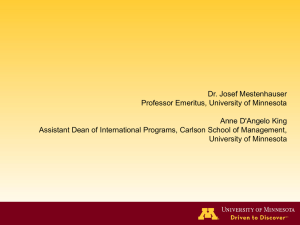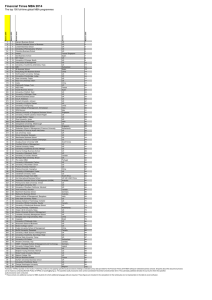
FACULTY MENTORSHIP LEADERSHIP PROGRAM
Developmental Network Mapping Exercise
Mentorship has been positively associated with career development and
productivity. New models of mentorship have transitioned from the
reliance on the dyadic (single mentor-mentee pair) and hierarchical
(mentor is senior to mentee) framework to Developmental Networks,
which emphasize the importance of relationships with people who help
get the work done, help advance one’s career, and/or provide personal
support. Developmental Networks may include traditional
scholarly/research mentors, advisors, peer mentors, e-mentors,
colleagues, juniors, mentees, family, and friends who provide access to
knowledge, opportunities, and resources across institutions and
cultures. The following steps will assist you in assessing your
Developmental Network relative to your career goals.
Draw your Developmental Network using the table and diagram on page 3 and the example on page 2.
The table on page 3 helps you reflect and identify the people who assist you in 3 different ways
People who help you get the job done
People who help you advance your career
People who provide personal support for you
And then list those people according to the closeness of the relationship you have with them.
People with whom you have more than one kind of relationship should be listed more than once (i.e. one person
could be in two or three categories). We also want you to place them in the column that best describes the type of
relationship you have with them. Close relationships are ones where there is a high degree of trust, liking and
mutual commitment. Distant relationships are ones where you don’t know the person very well. Moderate
relationships are in the middle, neither very close nor distant. The length of the line connecting each person back
to you represents the relative closeness of your relationship. Superiors, peers, and juniors are distinguished by
their placement around you.
Indicate by a star( ) those people whom you see as very well connected in your department, hospital or
professional circle, including someone who “sponsors” you. A sponsor is a senior/influential person who actively
advances your career trajectory. Write “mentor” or “mentee” inside the shape (square, triangle, or circle) of
anyone you consider in that role.
© S. Jean Emans, MD; Maxine Milstein, MBA; Ellen W. Seely, MD; and Audrey Haas, MBA; 2015.This Developmental Network
Exercise was adapted, with permission, from the work of Kathy Kram, PhD, (Boston University School of Management) by S.
Jean Emans, MD and Maxine Milstein, MBA (Boston Children’s Hospital) and Ellen W. Seely, MD and Audrey Haas, MBA
(Brigham & Women’s Hospital). All rights reserved. This material cannot be duplicated or used without permission.
1
EXAMPLE Developmental Network Table and Map
You: Junior Faculty
Types
Getting the Job Done: People who help you fulfill your work requirements. They provide technical
advice, introductions, expertise, and/or resources.
Close Relationship
NS, research assistant (Mentee)
Moderate Relationship
Distant Relationship
JD, PI of grant
CJ, administrative assistant
Advancing Your Career: People who contribute to your professional development and career
advancement. They provide career guidance and direction, advice on funding, serve as “sponsors” to
help you get important assignments, and advocate on your behalf.
Close Relationship
DR, senior faculty member in your
division (Mentor)
Moderate Relationship
Distant Relationship
JD, PI of grant
SW, Department Chair
AB, faculty at
another institution
Getting Personal Support: People you go to for your emotional well being and psychosocial support.
Close Relationship
LG, spouse
DR, senior faculty member in your
division (Mentor)
Moderate Relationship
FW, friend at work
Distant Relationship
Getting the Job Done
Advancing Your Career
Getting Personal Support
Senior to me
DR
Mentor
DR
Mentor
JD
JD
SW
R
AB
Peers
LG
ME
FW
NS
Mentee
Intra-organizational
Extra-organizational
well connected and/or “sponsors”
Junior to me
CJ
© S. Jean Emans, MD; Maxine Milstein, MBA; Ellen W. Seely, MD; and Audrey Haas, MBA; 2015.This Developmental Network
Exercise was adapted, with permission, from the work of Kathy Kram, PhD, (Boston University School of Management) by S.
Jean Emans, MD and Maxine Milstein, MBA (Boston Children’s Hospital) and Ellen W. Seely, MD and Audrey Haas, MBA
(Brigham & Women’s Hospital). All rights reserved. This material cannot be duplicated or used without permission.
2
Your Developmental Network Table and Map:
Types
Getting the Job Done: People who help you fulfill your work requirements. They provide technical
advice, introductions, expertise, and/or resources.
Close Relationship
Moderate Relationship
Distant Relationship
Advancing Your Career: People who contribute to your professional development and career
advancement. They provide career guidance and direction, advice on funding, serve as “sponsors” to
help you get important assignments, and advocate on your behalf.
Close Relationship
Moderate Relationship
Distant Relationship
Getting Personal Support: People you go to for your emotional well being and psychosocial support.
Close Relationship
Moderate Relationship
Distant Relationship
Intra-organizational
Extra-organizational
well connected and/or “sponsors”
© S. Jean Emans, MD; Maxine Milstein, MBA; Ellen W. Seely, MD; and Audrey Haas, MBA; 2015.This Developmental Network
Exercise was adapted, with permission, from the work of Kathy Kram, PhD, (Boston University School of Management) by S.
Jean Emans, MD and Maxine Milstein, MBA (Boston Children’s Hospital) and Ellen W. Seely, MD and Audrey Haas, MBA
(Brigham & Women’s Hospital). All rights reserved. This material cannot be duplicated or used without permission.
3
Analyzing and Maintaining Your Network
Networks vary in structure, content, and quality of relationships. Now that you have defined
your Developmental Network, assess if it meets your goals. The questions below will help you
determine the strengths and weaknesses of your network, and where you need to fill in gaps
with new contacts. Be mindful of maintaining existing relationships, by staying in touch and
“giving back” such as facilitating an introduction or sending an article of interest to the
individual along with your comments. Professional conferences are another important way to
reconnect with your existing developmental network and cultivate new connections.
Theme
Description
Diversity
How similar or different are these individuals (in terms of gender, race,
function, geography, organizations) to each other and to you?
Redundancy
How much overlap is there? Does one person serve every function? Do you
have many people helping you get the work done but no one providing
personal support?
Interconnectivity How closed is the network in the sense that most of the people know each
other?
Strength of
What is the spread of people in terms of closeness and distance to you?
Connection
Balance
Is your network balanced or in danger of tipping? Do you have too many
mentors and no mentees? Or for more senior faculty, do you have too
many mentees but no longer have mentors?
Connections to
How many individuals would you characterize as influential in the
Power/Influence department or hospital or field?
Size
How large or small is your network? Does the size fit your goals? Is the
network a size that you can maintain?
CONCLUSIONS ABOUT YOUR NETWORK:
Summarize the PATTERNS you see in your network; your STYLE of networking, and/or what you
might want to do differently in the future. Think about how to maintain the strengths of your
network, how to diversify, and how with time to increase the number of mentees and advisees.
© S. Jean Emans, MD; Maxine Milstein, MBA; Ellen W. Seely, MD; and Audrey Haas, MBA; 2015.This Developmental Network
Exercise was adapted, with permission, from the work of Kathy Kram, PhD, (Boston University School of Management) by S.
Jean Emans, MD and Maxine Milstein, MBA (Boston Children’s Hospital) and Ellen W. Seely, MD and Audrey Haas, MBA
(Brigham & Women’s Hospital). All rights reserved. This material cannot be duplicated or used without permission.
4









